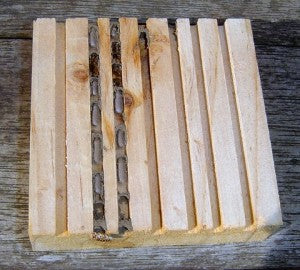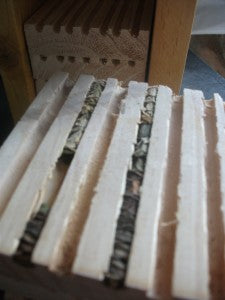Leafcutter bees are very similar to Mason Bees in many ways: they are non-aggressive, non-stinging, medium-sized, solitary cavity nesters, and will readily take up residence in our Solitary Bee Houses.


A major difference between the two species is the material they use to divide their brood cells. Unlike the Mason Bees, who use mud, the Leafcutter Bees use soft, flexible leaf pieces and flower petals to divide, line and cap their brood cells. They cut the leaves with their scissor-like mandibles, making smooth, circular or oval cuts from the edges of leaves that are about 1/2″ in diameter. According to The Xerces Society, it only takes two or three seconds for the female to cut a piece of leaf. Just before she finishes cutting it, the female starts to beat her wings, so she is already flying by the time the leaf fragment is severed. How cool is that??
The leaf pieces are then cemented together with salivary secretions and leaf resins. (Some of their favorite leaves are roses, lilac, red bud and Virginia creeper, but they don’t appear to be too choosey. Please don’t begrudge this housing material to these hard-working mothers! These missing leaf bits don’t damage the plant in any way.


It takes an average of 15 leaf pieces or flower petals to line one brood cell, and a total of 20 to 30 trips may be required to gather the necessary pollen and nectar to provision just one cell. Under favorable conditions a female bee may finish an average of 30 cells in her lifetime. A nesting tunnel filled with Leafcutter brood cells looks a lot like a hand-rolled cigar, and you can’t miss the beautiful green color of a leaf-capped nesting tunnel.
Like the Mason Bee, the Leafcutters provision each brood cell with a mixture of nectar and pollen, lay one egg, then seal the cell, continuing this sequence the length of the tunnel. When the tunnel is nearly filled with brood cells, the bee will then collect 30 to 50 circular pieces of leaf, which are deposited individually into the nest entrance. These circular pieces are cemented together, forming a solid plug which is flush with the hole entrance, and serves as a barrier against rain, predators and parasites. The young bees develop and remain within their individual cells, emerging in December/January — seamlessly timed to begin pollinating the summer flowers and vegetables. Mother Nature, in all her Glory.
Leafcutter Bee Builds a Brood Cell
http://www.youtube.com/watch?v=EjsZ419lmMY
These circular pieces are cemented together, forming a solid plug which is flush with the hole entrance, and serves as a barrier against rain, predators and parasites. The young bees develop and remain within their individual cells, emerging in December/January — seamlessly timed to begin pollinating the summer flowers and vegetables. Mother Nature, in all her Glory.
Leafcutter Bee Builds a Brood Cell
http://www.youtube.com/watch?v=EjsZ419lmMY
 These circular pieces are cemented together, forming a solid plug which is flush with the hole entrance, and serves as a barrier against rain, predators and parasites. The young bees develop and remain within their individual cells, emerging in December/January — seamlessly timed to begin pollinating the summer flowers and vegetables. Mother Nature, in all her Glory.
Leafcutter Bee Builds a Brood Cell
http://www.youtube.com/watch?v=EjsZ419lmMY
These circular pieces are cemented together, forming a solid plug which is flush with the hole entrance, and serves as a barrier against rain, predators and parasites. The young bees develop and remain within their individual cells, emerging in December/January — seamlessly timed to begin pollinating the summer flowers and vegetables. Mother Nature, in all her Glory.
Leafcutter Bee Builds a Brood Cell
http://www.youtube.com/watch?v=EjsZ419lmMY
